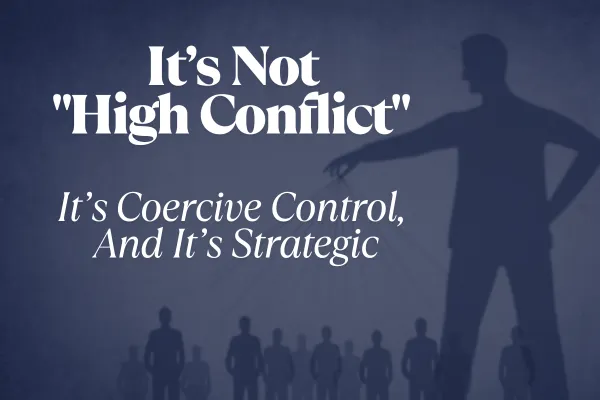
It’s Not “High Conflict.” It’s Coercive Control, And It’s Strategic
If you're going through a separation or divorce and every interaction feels like walking on eggshells, you're not alone. Maybe you've heard people describe your situation as "high conflict." But here's something important: it might be more than that. In many cases, it's not mutual fighting, it’s coercive control, and it’s intentional.
Understanding the difference can be life-changing. It can help you set boundaries, protect yourself, and stop blaming yourself for things that were never your fault to begin with.
What Is Coercive Control?

Coercive control is a pattern of behavior used to dominate, isolate, and manipulate someone—without necessarily using physical violence. It can include:
Constant criticism or gaslighting
Controlling money, schedules, or access to children
Threatening or using the legal system to instill fear
Isolating you from friends or family
Creating chaos to keep you emotionally off-balance
In a divorce or custody battle, this behavior doesn't stop. In fact, it often escalates, because the person losing control wants to keep it.
Why It’s Not Just “High Conflict”
The phrase "high conflict" implies that both people are equally responsible for the chaos—but that’s not always true.
Here’s a better way to think about it:
High conflict: Both parties are unable or unwilling to manage disagreements healthily.
Coercive control: One person is using manipulation and abuse to control the other.
If you’re the one trying to keep the peace, avoiding drama, and protecting your kids—you’re not the problem. Naming what’s really happening gives you the power to act.
Common Tactics of Coercive Control in Divorce
Understanding the strategies used can help you see the pattern, not just the chaos. Here are common signs:

Financial Abuse
Freezing accounts, refusing child support, or running up joint debt.
Legal Harassment (aka “Paper Abuse”)
Filing motion after motion to exhaust your money and emotional energy.
Surveillance and Stalking
Tracking your location, reading your emails, or using the kids as informants.

Using Children as Pawns
Trying to turn the kids against you, or threatening to take them away.
If any of this sounds familiar, know this: it's not your fault and you’re not imagining things.
Why Labeling It Correctly Matters
When professionals (lawyers, therapists, mediators) see your situation as simply "high conflict," they may:
Recommend co-parenting when it’s not safe
Push for mediation when it just gives your ex more access to harm
Assume you're exaggerating or just as combative
But when you and your team understand it as coercive control, you can:
Get safer custody arrangements
Set firmer boundaries
Seek professionals trained in trauma and abuse
What You Can Do Right Now

If this is hitting home, here are a few steps you can take:
Document Everything – Keep texts, emails, and notes of behaviors.
Talk to a Domestic Abuse-Informed Lawyer or Advocate – Not all professionals recognize coercive control. Find those who do.
Create a Safety Plan – Especially if you feel threatened or controlled.
Avoid Direct Conflict – Use communication tools like OurFamilyWizard or Talking Parents.
Get Support – Whether it’s therapy, a coach, or a support group, don’t do this alone.
You Are Not Alone
Going through a divorce is hard enough. Doing it with someone who uses coercive control can feel unbearable. But understanding what’s happening is the first step toward freedom, healing, and peace.
You deserve to feel safe. You deserve to feel heard. And most of all, you deserve to move forward without fear.
